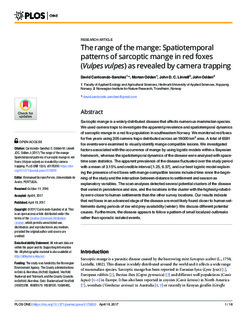The range of the mange: Spatiotemporal patterns of sarcoptic mange in red foxes (Vulpes vulpes) as revealed by camera trapping
Journal article, Peer reviewed
Published version

Åpne
Permanent lenke
http://hdl.handle.net/11250/2453748Utgivelsesdato
2017Metadata
Vis full innførselSamlinger
- Publikasjoner fra CRIStin - NINA [2397]
- Scientific publications [1423]
Originalversjon
10.1371/journal.pone.0176200Sammendrag
Sarcoptic mange is a widely distributed disease that affects numerous mammalian species. We used camera traps to investigate the apparent prevalence and spatiotemporal dynamics of sarcoptic mange in a red fox population in southeastern Norway. We monitored red foxes for five years using 305 camera traps distributed across an 18000 km2 area. A total of 6581 fox events were examined to visually identify mange compatible lesions. We investigated factors associated with the occurrence of mange by using logistic models within a Bayesian framework, whereas the spatiotemporal dynamics of the disease were analysed with spacetime scan statistics. The apparent prevalence of the disease fluctuated over the study period with a mean of 3.15% and credible interval [1.25, 6.37], and our best logistic model explaining the presence of red foxes with mange-compatible lesions included time since the beginning of the study and the interaction between distance to settlement and season as explanatory variables. The scan analyses detected several potential clusters of the disease that varied in persistence and size, and the locations in the cluster with the highest probability were closer to human settlements than the other survey locations. Our results indicate that red foxes in an advanced stage of the disease are most likely found closer to human settlements during periods of low wild prey availability (winter). We discuss different potential causes. Furthermore, the disease appears to follow a pattern of small localized outbreaks rather than sporadic isolated events.
